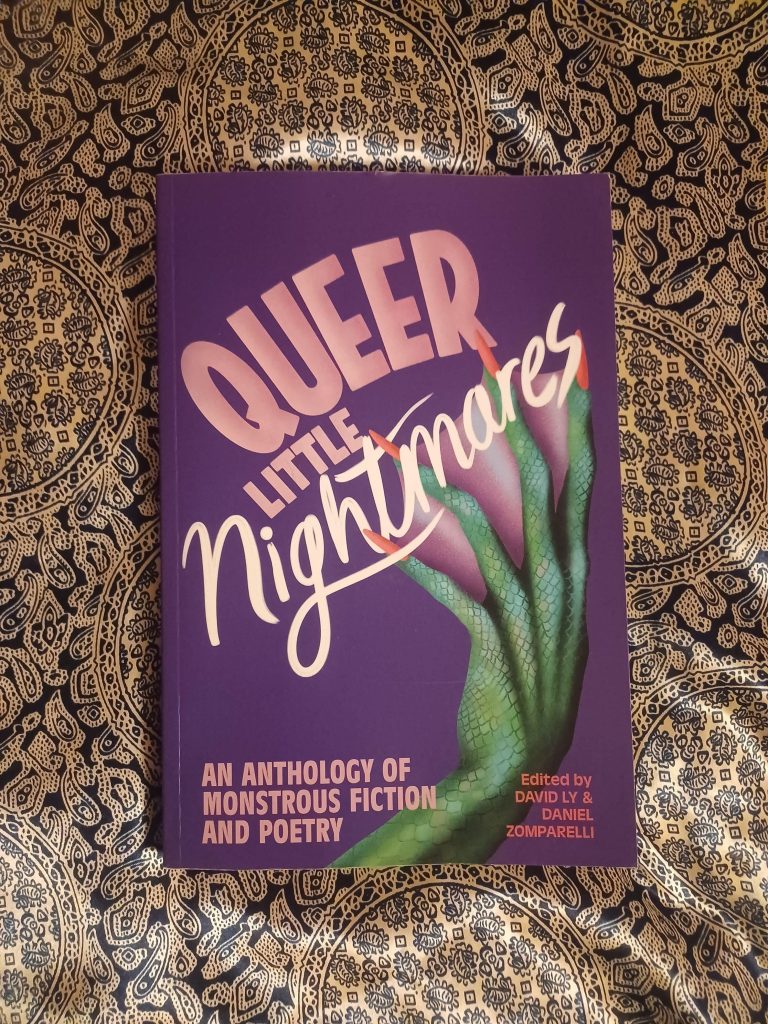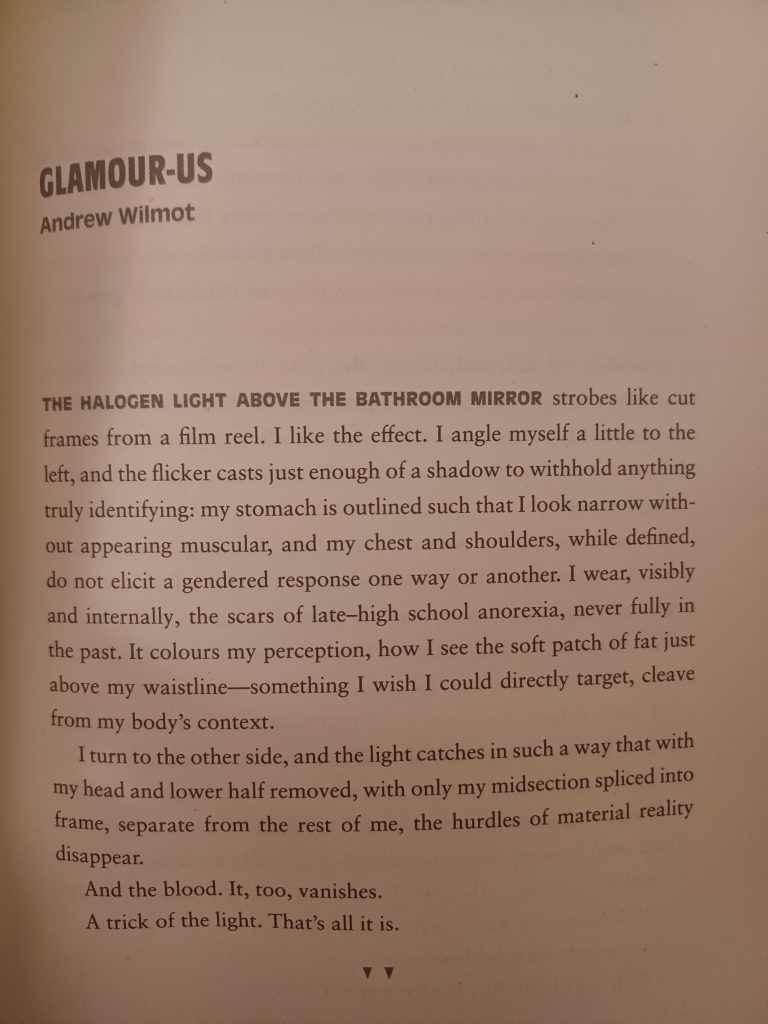Queer people are drawn to horror and the monstrous. According to cultural critics, this is because queerness was often portrayed as monstrous—from the lesbian gothic vampire Carmilla to Hitchcock’s heavily queer-coded villains in Psycho and Rebecca. Now, queer people have come to embrace monsters. Indeed, monsters and horror often subvert gender roles and heterosexual norms, which resonates with a queer audience who is fighting for their right to exist.

While North America has seen monumental progress in areas such as marriage equality, the recent rise of transphobic legislation and sentiment proves that the acceptance of LGBTQ+ people remains tenuous at best. As such, it is only natural for many LGBTQ+ people to continue feeling a connection to monstrosity. To investigate how and why queer people come to love monsters, I turned to Queer Little Nightmares: An Anthology of Monstrous Fiction and Poetry, an anthology featuring fiction and poetry from well-known Canadian authors such as Amber Dawn, David Demchuk, jaye simpson, and Kai Cheng Thom.
Each author approaches monstrosity and queerness from a unique perspective; some dive into various folklores, while others create something totally new. Monsters come from within oneself, are transformed, or become the object of the protagonist’s desire. Being a (specifically queer) monster brings power, confidence, and the chance to defend oneself against violence. Many of the protagonists of Queer Little Nightmares are also people of colour, which makes them even more vulnerable to violence—and leads to even greater triumphs if they can fight back and escape their oppressors. However, the anthology also contains works which follow a more traditional definition of “monstrous” acts, such as Blain’s “Ghosts of Pride Past,” which follows a gay police officer who has killed and prosecuted members of his community. Ly and Zomparelli, the editors of the collection, have included a diverse range of poetry and fiction which allows the reader to understand the pros and cons of embracing monstrosity.
Several authors, including Amber Dawn, Hiromi Goto, and David Ly, also explore body horror. Their works feature transformations awakened by the body going through natural phases, from puberty to menopause. Though I also appreciate the haunting stories, the visceral nature of these works ties in even better with queer horror. After all, regardless of whether it refers to genderqueerness or queer desires, much of humanity’s understanding of the word queer is rooted in the body. While many societies have social roles determined by gender, everything from sexual awakenings to descriptions of gender dysphoria are based on physicality, and stories which explore strange, new bodies represent these feelings well.
The stories in this collection that hit me the hardest are those exploring intersectional social issues, such as sexism, racism, ableism, and religious abuse, through the lens of speculative horror. Andrew Wilmot’s “Glamour-Us” is one of the collection’s most emotionally poignant short stories. In a not-so-distant future, technology allows people to create “glamours” that change their appearance, projecting their desired body over their real one. For enough money, one can even go a step further and upload their consciousness into a robotic form made to the desired specifications.

Wilmot’s story follows a small group of transgender friends who have mixed feelings about this technology; while one is eager to get her consciousness uploaded, another thinks it is better to transition in the traditional way by using hormones and surgeries to change the body. The nonbinary protagonist faces a unique kind of transphobia; because they are not always uncomfortable with their own body, their opinion is largely disregarded. However, the glamour technology holds a lot of promise and would allow them to transform into whichever body suits them in the moment. Unfortunately, after some interpersonal drama, a tragic event shows the vulnerability of becoming a synth. Wilmot not only explores horror through the uncanny and the creation of synthetic life, but also shows the violence transgender people face regardless of how they choose to present themselves. Wilmot effortlessly captures the in-jokes and messiness of a queer friend group and the ethereal and awful sides of living in a cyberpunk world.
Another excellent short story is jaye simpson’s retelling of the classic myth of Medusa, “#WWMD?”. Taking place in contemporary Vancouver, the story follows a transgender indigenous woman who is stalked by a strange man with intense blue eyes. After being harassed by security in a nightclub and running into the stranger again, she realizes she is being pulled into the story of Medusa, which in this world is a constant cycle; each generation, a new woman must be chosen to fulfill the role. The protagonist must now cope with her role in this story and the changes to her body that come with becoming Medusa. simpson’s work is always exquisite, and their exploration of the destiny placed on an unsuspecting bystander and the struggles of navigating such a momentous change subverts the perception of Medusa as a monster in a unique way.
While there are several excellent poems in the collection, including two by Kai Cheng Thom, my favourites are Jessica Cho’s “Declassified” and Victoria Mbabazi’s “The Creation of Eve.” “Declassified” is about two women swapping monster stories, juxtaposed with the vivid queer fantasies one woman has about the other. “The Creation of Eve” speculates how a lesbian Eve might feel and with whom she might fall in love. The contrast in the formats of the poems–shorter and longer lines, clearer descriptions and vagueness–allows for unique explorations of queer female desire. Mbabazi’s poem shows how Eve could be turned into a villain for loving a demon, while Cho’s poem focuses more on a desire to escape that comes from within.
Ultimately, Queer Little Nightmares is an excellent anthology that highlights why LGBTQ+ people love monsters and horror. Each author takes the theme in a different direction, ensuring that there is something in this book for every reader. This anthology is also an excellent reminder that while broad horror themes may be cultural, the feelings evoked by horror are unique to each person who views it. Any reader who picks up this book is in for a spine-tingling anthology of incredible contemporary horror or monster fiction, and I can not recommend it enough.
